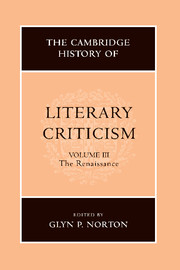Book contents
- Frontmatter
- Introduction
- READING AND INTERPRETATION: AN EMERGING DISCOURSE OF POETICS
- POETICS
- THEORIES OF PROSE FICTION
- CONTEXTS OF CRITICISM: METROPOLITAN CULTURE AND SOCIO-LITERARY ENVIRONMENTS
- VOICES OF DISSENT
- STRUCTURES OF THOUGHT
- NEOCLASSICAL ISSUES: BEAUTY, JUDGEMENT, PERSUASION, POLEMICS
- 51 Combative criticism: Jonson, Milton, and classical literary criticism in England
- 52 The rhetorical ideal in France
- 53 Cartesian aesthetics
- 54 Principles of judgement: probability, decorum, taste, and the je ne sais quoi
- 55 Longinus and the Sublime
- A SURVEY OF NATIONAL DEVELOPMENTS
- Bibliography
- Index
- References
51 - Combative criticism: Jonson, Milton, and classical literary criticism in England
from NEOCLASSICAL ISSUES: BEAUTY, JUDGEMENT, PERSUASION, POLEMICS
Published online by Cambridge University Press: 28 March 2008
- Frontmatter
- Introduction
- READING AND INTERPRETATION: AN EMERGING DISCOURSE OF POETICS
- POETICS
- THEORIES OF PROSE FICTION
- CONTEXTS OF CRITICISM: METROPOLITAN CULTURE AND SOCIO-LITERARY ENVIRONMENTS
- VOICES OF DISSENT
- STRUCTURES OF THOUGHT
- NEOCLASSICAL ISSUES: BEAUTY, JUDGEMENT, PERSUASION, POLEMICS
- 51 Combative criticism: Jonson, Milton, and classical literary criticism in England
- 52 The rhetorical ideal in France
- 53 Cartesian aesthetics
- 54 Principles of judgement: probability, decorum, taste, and the je ne sais quoi
- 55 Longinus and the Sublime
- A SURVEY OF NATIONAL DEVELOPMENTS
- Bibliography
- Index
- References
Summary
English literary criticism between 1580 and 1670 is often regarded as the poor relation of Europe. The classicizing remarks of many English critics in the period might seem on the face of it to justify this opinion. In 1591 Sir John Harington, in his defence of Ariosto's Orlando furioso, claimed that neoclassical critics ‘would have an heroicall Poem (as well as a Tragedie) to be full of Peripeteia, which I interpret an agnition of some unlooked for fortune either good or bad, and a sudden change thereof: of this what store there be the reader shall quickly find’. Aristotle does argue that anagnorisis (Harington's ‘agnition’) and peripeteia (‘reversal of fortune’) should ideally coincide (Poetics 1452a), but he would balk at Harington's conflation of the two into a composite which can be liberally sprinkled over any heroic poem. Edmund Spenser also shows a weak grasp on neoclassical principles and vocabulary in his Letter to Ralegh, appended to The Faerie Queene (1590). He shows some awareness of Horace's recommendation that a heroic poem should not begin ‘ab ovo’ (Ars poetica 147): ‘a Poet thrusteth into the middest, … and there recoursing to the thinges forepast, and diuining of thinges to come, maketh a pleasing analysis of all’. But his critical remarks are belied by his practice: The Faerie Queene does not begin in the middle of a single action in anything like the sense that Spenser, or Horace, claimed it should. In the same period George Puttenham presented his Arte of English poesie (published 1589) in the form of a rhetorical manual, which minimizes the importance of narrative structure in favour of the schemes and tropes of rhetoric.
- Type
- Chapter
- Information
- The Cambridge History of Literary Criticism , pp. 485 - 499Publisher: Cambridge University PressPrint publication year: 1999



